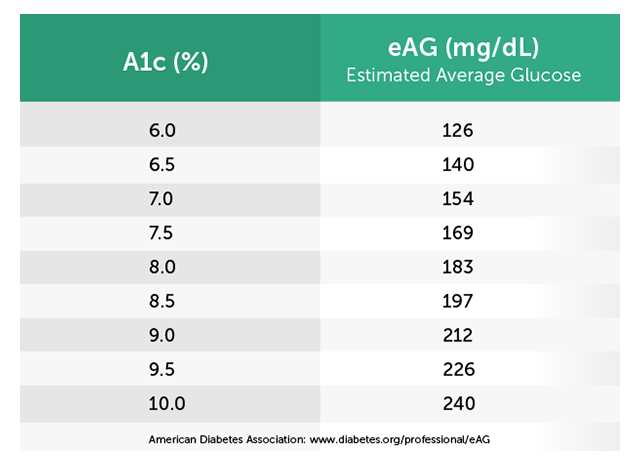A1c – An Important Blood Test
A1c is a blood test that shows you what your diabetes control has been for 2-3 months. The A1c and your daily blood sugar levels let your doctor see how well you are managing your diabetes. There is now a new term known as eAG. The eAG is a better way to explain the A1c.
What is “estimated Average Glucose” (eAG)?
eAG stands for Estimated Average Glucose. This term is a measurement that directly relates to the A1c blood test. The A1c has been the standard measure of diabetes control for many years. The chart below shows how the A1c directly relates to the eAG:

How the A1c Test Works
Hemoglobin is one part of the red blood cell. It carries oxygen through the body. The sugar in your blood attaches to the hemoglobin and stays there for the life of that red blood cell. The glucose-hemoglobin part of the red blood cell is called the A1c. The A1c measures the percent of hemoglobin that has sugar attached to it. Since red blood cells live for approximately 90 days, they carry the memory of all your blood sugar levels. The A1c shows what your diabetes control has been for the past 3 months. A blood sample using your glucose monitor shows you what your blood sugar is at that moment.
How the A1c Test is Administered
The process for this test is easier than getting the actual results. Since little blood is actually needed the doctor will painlessly draw a small sample of blood. If their office is equipped for it, they can provide you instant results, otherwise it may take a few days to get your results back. The entire process takes only a moment and is virtually painless. No fasting is required for this process, unlike a standard glucose test.
What is a good A1c level?
For people without diabetes, the normal A1c range is between 4-6%. When the results of your A1c fall in the normal range, it means your blood sugar levels have been in the target range. Results may vary slightly from one lab to another. Check with your doctor to find out what the normal range is for the lab he/she uses. Research has shown that keeping A1c levels at 7% or lower helps prevent or delay the long-term complications of diabetes.*
What are some limitations of the A1c test?
The testing cannot break down the daily spikes and falls in your glucose. Daily monitoring is essential to help maintain your overall health. Additionally, the type of test administered and the lab that reviews it will provide different results. This is no replacement for your standard glucose meter.
Additionally these results can be misleading. Since there is no way to determine the actual age of the hemoglobin, a newer cell will provide different results from an older cell. For instance, if a person has anemia the results will produce a false high, where a person with hemolysis will have a lower result.
Important Things to Remember:
Know what your A1c results are and what they mean. This tells you how well you have been controlling your diabetes.
Keep a record of your A1c results.
The A1c measures blood sugar control for 3 months. The American Diabetes Association recommends that the A1c be done every 3 months. If the blood sugar is under good control, it can be done twice a year.*
Using eAG may help you better understand how you are controlling your diabetes.
How can your doctor help you?
Your doctor should inform you of your A1c results. These results show how well you are doing with your overall diabetes care. Together, you should review your A1c, eAG and your blood sugar levels. This may show you what steps are needed to help you manage your diabetes.
Source: American Diabetes Association: Diabetes Care, Volume 37, Supplement 1,
January 2014, S23.
